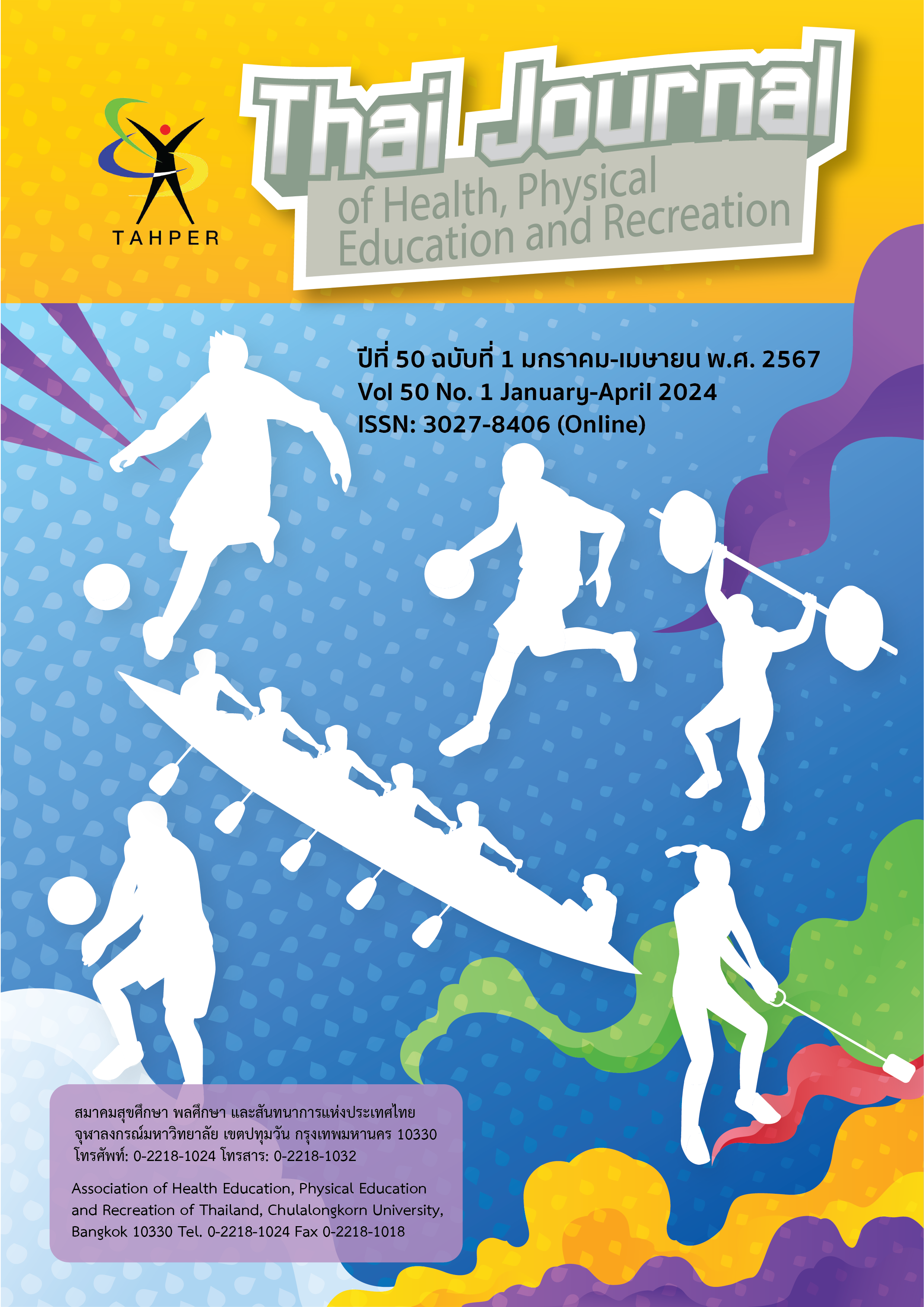Health Promotion Activities to Develop Physical Fitness of Nakhon Phanom University Students
Main Article Content
Abstract
The purposes of this research were to study effect of health promotion program to develop the physical fitness of students in NakhonPhanom University students. The research model was the one group pretest posttest experimental design. The sample group was 25 students which were purposive sampling. The instrument consisted of physical exercise activities program and physical fitness test. The experiment executed by participated in the developed physical exercise program for 8 weeks, five days a week, with 120 minutes a day. The physical fitness tests were collected at before and after the experiment. The data were analyzed by descriptive statistics and paired t-test with statistic significant level at .05. The results showed that the physical fitness in limb strength, body weight, body mass index, flexibility and oxygen consumption were increased at the .05 level of significance, but the subcutaneous fat and resting pulse were decreased with were not significant difference. When comparing the volunteers’ level of physical fitness to the criteria, it was discovered that female students had an average of 27.60 of subcutaneous fat. The degree of assessment was moderate on average. Males scored on average 19.50. The mean score was very low. The physical fitness of female flexibility was 9.54, the mean assessment level was low. Males had an average of 11.26. The mean rating was moderate. In terms of arm muscle strength, men and women's respective means were .46 and .55. The average score was low. The female had an average leg muscle strength score of 1.24 and an average rating of very good. The average for men was 1.51. The average score is moderate. As for the oxygen utilization capacity of females, the mean was 23.33 and the male was 26.52. The rating was relatively poor on average.
Article Details

This work is licensed under a Creative Commons Attribution-NonCommercial-NoDerivatives 4.0 International License.
Critical thinking in journals is the right of the author. The Association of Health Education, Physical Education and Recreation of Thailand is not always required, to create diversity in ideas and creativity.
ความคิด ข้อวิพากษ์ในวารสารเป้นสิทธิของผู้เขียน สมาคมสุขศึกษา พลศึกษา และสันทนาการแห่งประเทศไทยไม่จำเป็นต้องเห็นชอบด้วยเสมอไป เพื่อให้เกิดความหลากหลายในความคิดและความสร้างสรรค์
References
การกีฬาแห่งประเทศไทย. (2545). เกณฑ์มาตรฐานสมรรถภาพทางกายประชาชนไทย. กรุงเทพฯ: นิวไตรมิตรการพิมพ์.
พิมผกา ปัญโญใหญ่. (2555). การออกกำลังกายแบบแอโรบิคสำหรับผู้สูงอายุ. วารสารพยาบาลศาสตร์และสุขภาพ, 35(2), 140-148.
สำนักงานสถิติแห่งชาติ. (2558). การสำรวจกิจกรรมทางกายของประชากร พ.ศ. 2558. สืบค้นเมื่อ 8 ธันวาคม 2565, สือค้นจากhttps://www.m-society.go.th/ewtadmin/ewt/mso_web/article_attach/18375/20283.pdf.
อภิวัฒน์ ปัญญามี. (2565). แนวทางการพัฒนาบริการทางการกีฬาและการออกกำลังกายในสถาบันการพลศึกษา. วารสารสุขศึกษา พลศึกษา และสันทนาการ, 48(1), 60-74.
Andrew, RM., Long, BC., & Goad, CL. (2014). Effect of foam rolling and static stretching on passive hip-flexion range of motion. Journal of Sport Rehabilitation, 23(4), 296-299.
Andersen, LB., Riddoch, C., Kriemler, S, & Hills, A. (2011). Physical activity and cardiovascular risk factors in children. British Journal Sports Medicine, 45(11), 871-876.
Farthin, JP., & Chilibeck, PD. (2003). The effects of eccentric and concentric training at different velocities on muscle hypertrophy. European Journal of Applied Physiology, 89(6), 578-586.
Nicklas, TA., von Duvillard, SP., & Berenson, GS. (2002). Tracking of serum lipids and lipoproteins from childhood to dyslipidemia in adults: The Bogalusa Heart Study. International Journal of Sport Medicine, Suppl 1: S39-43.
Ortega, FB, Ruiz, JR, Castillo, MJ, & Sjostrom, M. (2008). Physical fitness in childhood and adolescence: a powerful marker of health. International Journal of Obesity, 32(1), 1-11.
Panyamee, A. (2022). The guidelines to develop sports and exercise services in the institute of physical education. Journal of Health, Physical Education and Recreation, 48(1), 60-74.
Ploutz-Snyder, LL., Convertino, VA., & Dudley, GA. (1995). Resistance exercise-induced fluid shifts: Change in active muscle size and plasma volume. American Journal of physiology, 269(3Pt2) R536-543.
Ramsbotton, R., Brewer, J., & Williams, C. (1988). A progressive shuttle run test to estimate maximal oxygen uptake. British Journal of sports Medicine, 22(4), 141-144.
Srisuk, S. (2023). Physical performances adaptation during concurrent high-intensity continuous training in adolescents. International Journal of Physical Education, Sports and Health, 10(4), 86-90.
Verdijk, LB., Gleeson, BG., Jonkers, RAM, Meijer, K., Savelberg Hans, HCM., Dendale, P., & van Loon Luc, JC. (2009). Skeletal muscle hypertrophy following resistance training is accompanied by a fiber type-specific increase in satellite cell content in elderly men. The Journals of Gerontology. Series A, Biological Sciences and Medical Sciences, 64(3), 332-339.
World Health Organization. (2000). Obesity: preventing and managing the global epidemic. Report of a WHO consultation. https://apps.who.int/iris/handle/10665/42330


